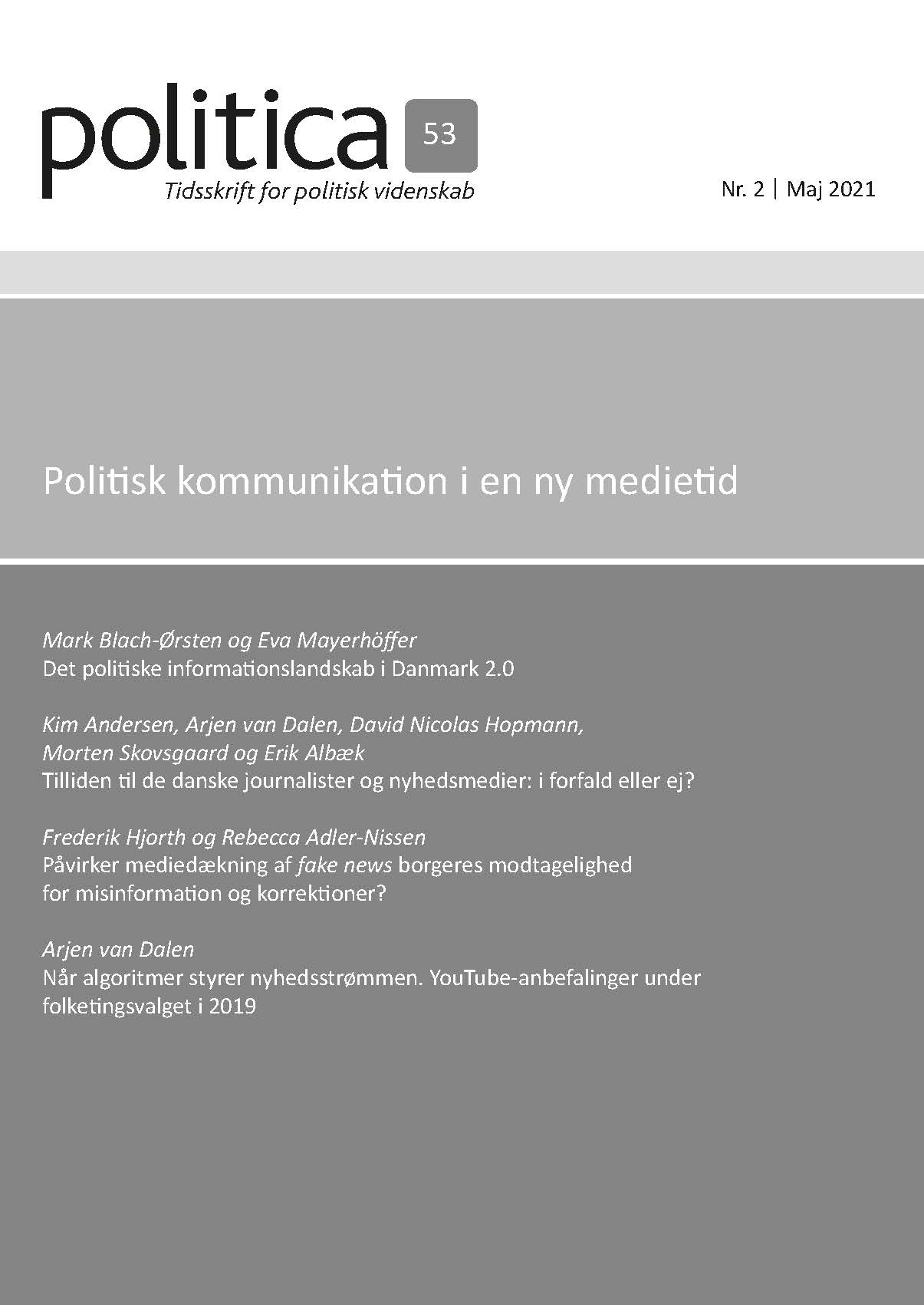Påvirker mediedækning af fake news borgeres modtagelighed for misinformation og korrektioner?
DOI:
https://doi.org/10.7146/politica.v53i2.130384Nøgleord:
misinformation, fake news, eksperimenter, medietillidResumé
I de senere år har politisk misinformation, populært kaldet fake news, nydt stor bevågenhed. Det rejser spørgsmålet, hvorvidt denne opmærksomhed i sig selv påvirker, hvordan borgere reagerer på politiske nyheder. Vi adresserer dette spørgsmål ved først at udvikle teoretiske forventninger om, hvordan opmærksomhed på politisk misinformation påvirker borgeres modtagelighed over for politisk information. Vi tester disse teoretiske forventninger i et præregistreret surveyeksperiment, som vi udfører i samarbejde med et dansk nyhedsmedie. Resultaterne viser, modsat den teoretiske forventning, at respondenter, der eksperimentelt gøres opmærksom på fake news som fænomen, ikke efterfølgende er mindre modtagelige over for politisk information. Dette resultat indikerer, at medier kan dække politisk misinformation som fænomen uden væsentlig risiko for, at denne debat i sig selv undergraver tillid til medier og politikere.
Referencer
Allcott, Hunt og Matthew Gentzkow (2017). Social media and fake news in the 2016 Election. Journal of Economic Perspectives 31 (2): 211-236.
Berinsky, Adam J. (2017). Rumors and health care reform: Experiments in political misinformation. British Journal of Political Science 47 (2): 241-262.
Brummette, John, Marcia DiStaso, Michail Vafeiadis og Marcus Messner (2018). Read all about it: The politicization of fake news on Twitter. Journalism & Mass Communication Quarterly 95 (2): 497-517.
Cappella, Joseph N. og Kathleen Hall Jamieson (1997). Spiral of Cynicism: The Press and the Public Good. Oxford: Oxford University Press.
Cobb, Michael D., Brendan Nyhan og Jason Reifler (2013). Beliefs don’t always persevere: How political figures are punished when positive information about them is discredited. Political Psychology 34 (3): 307-326.
Collignon, Pierre (2018). Tilbage til virkeligheden: kampen mod fake news, løgne og manipulationer. København: Gyldendal.
Druckman, James N. og Thomas J. Leeper (2012). Learning more from political communication experiments: Pretreatment and its effects. American Journal of Political Science 56 (4): 875-896.
Egelhofer, Jana Laura, Loes Aaldering, Jakob-Moritz Eberl, Sebastian Galyga og Sophie Lecheler (2020). From Novelty to Normalization? How Journalists Use the Term fake news in Their Reporting. Journalism Studies 21 (10): 1323-1343.
Flynn, D.J., Brendan Nyhan og Jason Reifler (2017). The nature and origins of misperceptions: Understanding false and unsupported beliefs about politics. Political Psychology 38 (1): 127-150.
King, Gary, Michael Tomz og Jerry Wittenberg (2000). Making the most of statistical analyses: Improving interpretation and presentation. American Journal of Political Science 44 (2): 341-355.
Kuklinski, James H., Paul J. Quirk, Jennifer Jerit, David Schwieder og Robert F. Rich (2000). Misinformation and the currency of democratic citizenship. The Journal of Politics 62 (3): 790-816.
Ladd, Jonathan M. (2012). Why Americans Hate the Media and How It Matters. Princeton: Princeton University Press.
Lewandowsky, Stephan, Ullrich K.H. Ecker, Colleen M Seifert, Norbert Schwarz og John Cook (2012). Misinformation and its correction: Continued influence and successful debiasing. Psychological Science in the Public Interest: A Journal of the American Psychological Society 13 (3): 106-131.
Li, S Xin (2010). Social identities, ethnic diversity, and tax morale. Public Finance Review 38 (2): 146-177.
Love, Robert (2007). Before Jon Stewart. Columbia Journalism Review 45 (6): 33-37.
Lund, Anker Brink (2013). Mangfoldighed i dansk dagspresse: et publicistisk serviceeftersyn. København: Center for Civilsamfundsstudier, CBS.
Miller, Joanne M. og Jon A. Krosnick (2000). News media impact on the ingredients of presidential evaluations: Politically knowledgeable citizens are guided by a trusted source. American Journal of Political Science 44 (2): 301-315.
Nisbett, Richard E. og Timothy D. Wilson (1977). Telling more than we can know: Verbal reports on mental processes. Psychological Review 84 (3): 231-259.
Nyhan, Brendan (2020). Facts and myths about misperceptions. Journal of Economic Perspectives 34 (3): 220-236.
Nyhan, Brendan og Jason Reifler (2010). When corrections fail: The persistence of political misperceptions. Political Behavior 32 (2): 303-330.
Nyhan, Brendan og Jason Reifler (2015a). The effect of fact-checking on elites: A field experiment on U.S. state legislators. American Journal of Political Science 59 (3): 628-640.
Nyhan, Brendan og Jason Reifler (2015b). Displacing misinformation about events: An experimental test of causal corrections. Journal of Experimental Political Science 2 (1): 81-93.
Nyhan, Brendan, Ethan Porter, Jason Reifler og Thomas Wood (2017). Taking Corrections Literally But Not Seriously? The Effects of Information on Factual Beliefs and Candidate Favorability. https://papers.ssrn.com/sol3/papers.cfm?abstract_id=2995128
Pomerantsev, Peter (2015). The Kremlin’s information war. Journal of Democracy 26 (4): 40-50.
Porter, Ethan og Thomas J. Wood (2019). False Alarm: The Truth about Political Mistruths in the Trump Era. Cambridge: Cambridge University Press.
Ross, Lee, Mark R. Lepper og Michael Hubbard (1975). Perseverance in self-perception and social perception: Biased attributional processes in the debriefing paradigm. Journal of Personality and Social Psychology 32 (5): 880-892.
Thorson, Emily (2016). Belief echoes: The persistent effects of corrected misinformation. Political Communication 33 (3): 460-480.
Tong, Chau, Hyungjin Gill, Jianing Li, Sebastián Valenzuela og Hernando Rojas (2020). “Fake news is anything they say!” Conceptualization and weaponization of fake news among the American public. Mass Communication and Society 23 (5): 755-778.
Tsfati, Yariv (2003). Does audience skepticism of the media matter in agenda setting?” Journal of Broadcasting & Electronic Media 47 (2): 157-176.
Vallone, Robert P., Lee Ross og Mark R. Lepper (1985). The hostile media phenomenon: Biased perception and perceptions of media bias in coverage of the Beirut massacre. Journal of Personality and Social Psychology 49 (3): 577-585.
Watts, Mark D., David Domke, Dhavan V. Shah og David P. Fan (1999). Elite cues and media bias in presidential campaigns: Explaining public perceptions of a liberal press. Communication Research 26 (2): 144-175.
Wood, Thomas og Ethan Porter (2019). The elusive backfire effect: Mass attitudes’ steadfast factual adherence. Political Behavior 41 (1): 135-163.
Ørsten, Mark og Ida Willig (2016). Det danske mediesystem, pp. 13-34 i Thomas Olesen (red.), Medier, politik og samfund. København: Hans Reitzels Forlag.
Downloads
Publiceret
Citation/Eksport
Nummer
Sektion
Licens
LicensOphavsretten tilhører Politica. Materialet må ikke bruges eller distribueres i kommercielt øjemed.





